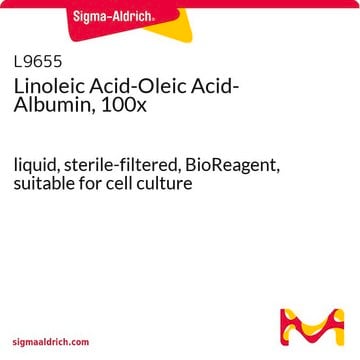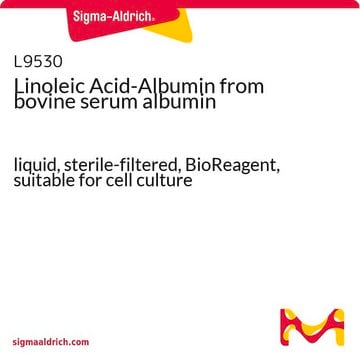The concentration of BSE in this product is approximately 100 mg/mL in DPBS. The lot-specific concentration is reported in the Certificate of Analysis as "Protein by Biuret". Please see the link below to review a sample or lot specific Certificate:
https://www.sigmaaldrich.com/product/sigma/o3008#product-documentation
Wichtige Dokumente
O3008
Oleinsäure-Albumin aus Rinderserum
liquid, sterile-filtered, BioReagent, suitable for cell culture
Synonym(e):
Oleinsäure-BSA-Komplex
Größe auswählen
About This Item
Empfohlene Produkte
Biologische Quelle
bovine
Sterilität
sterile-filtered
Produktlinie
BioReagent
Form
liquid
Zusammensetzung
Oleic acid, 2 mol/mol albumin
Konzentration
100 mg/mL BSA in DPBS
90-120 mg/mL protein (biuret)
Methode(n)
cell culture | mammalian: suitable
Verunreinigungen
endotoxin, tested
Lagertemp.
2-8°C
Anwendung
Biochem./physiol. Wirkung
Ähnliches Produkt
Lagerklassenschlüssel
10 - Combustible liquids
WGK
WGK 3
Flammpunkt (°F)
Not applicable
Flammpunkt (°C)
Not applicable
Persönliche Schutzausrüstung
Eyeshields, Gloves
Hier finden Sie alle aktuellen Versionen:
Analysenzertifikate (COA)
Die passende Version wird nicht angezeigt?
Wenn Sie eine bestimmte Version benötigen, können Sie anhand der Lot- oder Chargennummer nach einem spezifischen Zertifikat suchen.
Besitzen Sie dieses Produkt bereits?
In der Dokumentenbibliothek finden Sie die Dokumentation zu den Produkten, die Sie kürzlich erworben haben.
Kunden haben sich ebenfalls angesehen
Artikel
Supplement cell culture systems with fatty acids for biomanufacturing heterologous proteins like monoclonal antibodies.
How the unsaturated fatty acid, oleic acid and other cell culture components affect the performance of serum-free, protein-free cell culture systems used for biomanufacturing heterologous proteins including monoclonal antibodies.
-
What is the bsa concentration in the solution?
1 answer-
Helpful?
-
-
Is it suitable to store this reagent in -20C in aliquots? We received our order recently and the shipping box has a large label of "Do not Freeze" I was inquiring if there was a decrease in concentration if frozen?
1 answer-
To effectively preserve the integrity of this product, it should be stored at the recommended temperature and protected from light. The stability and optimal performance may be impacted by the freeze/thaw process. This product should be stored at 2 to 8 C.
Helpful?
-
-
How is the binding of oleic acid to BSA is confirmed?
1 answer-
Many fatty acids have a natural affinity to some plasma proteins. In this case BSA serves as a carrier or transporter of the insoluble oleic acid. The product is tested for protein and oleic acid content, only. No additional testing is performed to confirm the complex formation. See the following publications for further information:
https://pubmed.ncbi.nlm.nih.gov/236351/
https://pubmed.ncbi.nlm.nih.gov/19745557/#:~:text=Albumin%20acts%20as%20main%20fatty,a%20several%20orders%20of%20magnitudeHelpful?
-
-
What is the concentration of Oleic Acid in this product in Molarity (M) or milimolarity (mM)? I need this to be able to follow a protocol
1 answer-
Oleic acid has a molecular mass of 282.47 g/mol. In order to find the concentration of oleic acid in a specific lot, use the Oleic acid concentration on the lot-specific certificate of analysis (COA).
The equation used to find the concentration is as follows: (molar mass of Oleic acid) x (concentration of Oleic acid from COA), this will result in units of liter/mole which can be multiplied by the reciprocal, resulting in units of Molarity (mole/liter).
For example, for lot number SLCM9550, the Oleic acid concentration is reported as 940 ug/mL.
282.47 g/mol / 0.94 g/L =300.5 L/mol
1/300.5= 0.003327 M (mol/liter) = 3.33 mM Oleic AcidHelpful?
-
-
Through what method is oleic acid complexed to BSA?
1 answer-
Unfortunately, the method of preparation considered proprietary.
Helpful?
-
Active Filters
Unser Team von Wissenschaftlern verfügt über Erfahrung in allen Forschungsbereichen einschließlich Life Science, Materialwissenschaften, chemischer Synthese, Chromatographie, Analytik und vielen mehr..
Setzen Sie sich mit dem technischen Dienst in Verbindung.







